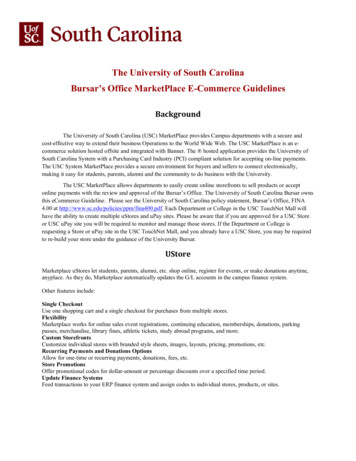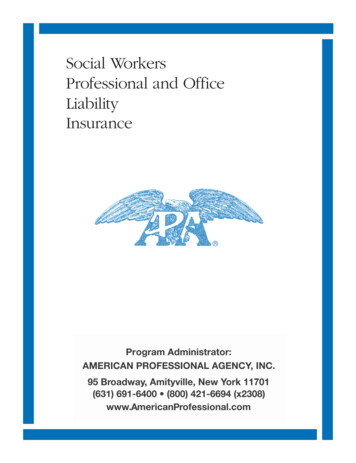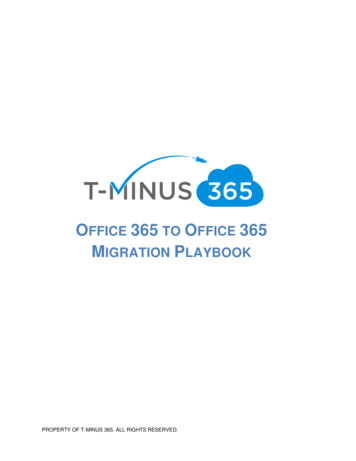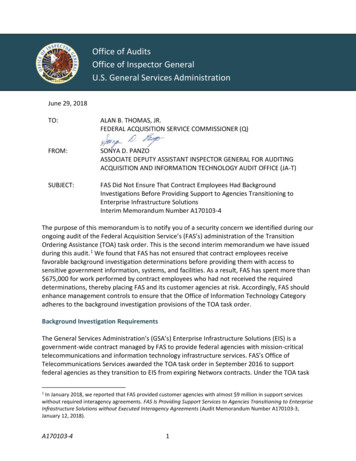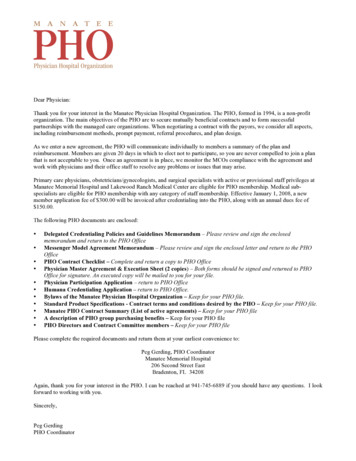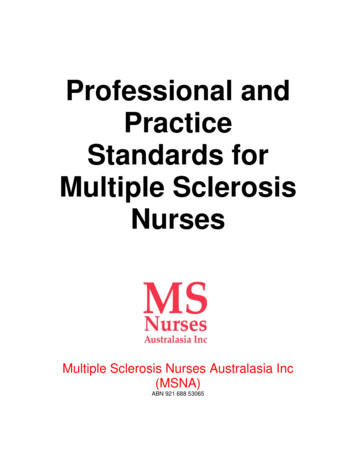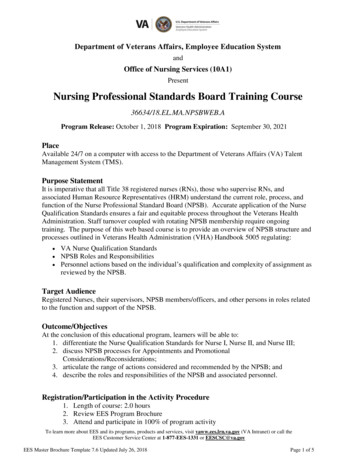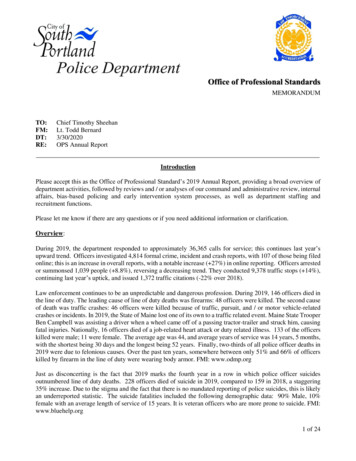
Transcription
Office of Professional StandardsMEMORANDUMTO:FM:DT:RE:Chief Timothy SheehanLt. Todd Bernard3/30/2020OPS Annual ReportIntroductionPlease accept this as the Office of Professional Standard’s 2019 Annual Report, providing a broad overview ofdepartment activities, followed by reviews and / or analyses of our command and administrative review, internalaffairs, bias-based policing and early intervention system processes, as well as department staffing andrecruitment functions.Please let me know if there are any questions or if you need additional information or clarification.Overview:During 2019, the department responded to approximately 36,365 calls for service; this continues last year’supward trend. Officers investigated 4,814 formal crime, incident and crash reports, with 107 of those being filedonline; this is an increase in overall reports, with a notable increase ( 27%) in online reporting. Officers arrestedor summonsed 1,039 people ( 8.8%), reversing a decreasing trend. They conducted 9,378 traffic stops ( 14%),continuing last year’s uptick, and issued 1,372 traffic citations (-22% over 2018).Law enforcement continues to be an unpredictable and dangerous profession. During 2019, 146 officers died inthe line of duty. The leading cause of line of duty deaths was firearms: 48 officers were killed. The second causeof death was traffic crashes: 46 officers were killed because of traffic, pursuit, and / or motor vehicle-relatedcrashes or incidents. In 2019, the State of Maine lost one of its own to a traffic related event. Maine State TrooperBen Campbell was assisting a driver when a wheel came off of a passing tractor-trailer and struck him, causingfatal injuries. Nationally, 16 officers died of a job-related heart attack or duty related illness. 133 of the officerskilled were male; 11 were female. The average age was 44, and average years of service was 14 years, 5 months,with the shortest being 30 days and the longest being 52 years. Finally, two-thirds of all police officer deaths in2019 were due to felonious causes. Over the past ten years, somewhere between only 51% and 66% of officerskilled by firearm in the line of duty were wearing body armor. FMI: www.odmp.orgJust as disconcerting is the fact that 2019 marks the fourth year in a row in which police officer suicidesoutnumbered line of duty deaths. 228 officers died of suicide in 2019, compared to 159 in 2018, a staggering35% increase. Due to the stigma and the fact that there is no mandated reporting of police suicides, this is likelyan underreported statistic. The suicide fatalities included the following demographic data: 90% Male, 10%female with an average length of service of 15 years. It is veteran officers who are more prone to suicide. FMI:www.bluehelp.org1 of 24
These somber statistics substantiate the department’s efforts in both providing and mandating the use of softbody armor, specialized ballistic doors in the patrol vehicles, specialized (e.g., armored) vehicles, equipment,teams and training, firearms training, restrictive response and pursuit guidelines, and high visibility vehicles andequipment. Additionally, the department requires the administrative review of high liability incidents and hasthe annual physical fitness program – inclusive of facilities and incentives. Finally, the department benefits froman early intervention system, employee assistance program, peer support, and critical incident stress protocolsoverseen or coordinated by our internal Behavioral Health Liaison. In 2019, our Behavioral Health Liaisonorganized several gatherings to increase awareness of peer support and encouraged officers to seek help througha guide. In addition, the BHL provided two trainings, one on ending the stigma related to mental health and oneon officer resiliency.Notwithstanding the current national climate, and the threats officers face every day, our agency is held in highesteem in the South Portland community and the Maine law enforcement profession. Our officers continue tobalance the department’s mission of working cooperatively with all citizens to protect life and property, preservethe peace, enforce the law and maintain civil rights through proper and responsive community based service,while ensuring both the public’s and their own safety. In light of the significant number of contacts our officershave with the public, often during stressful, tense and chaotic situations, I hope you will agree that the data,reviews and analyses contained herein indicate that our officers continue to conduct themselves not only withthe restraint and professionalism that is both expected of and regularly demonstrated by them, but with the spiritand intent of our Mission Statement and our Guiding Values.Trends:Opioid CrisisIn 2017, Maine was among the top tenstates with the highest overdose deathsinvolving opioids in the U.S. There were360 overdose deaths involving opioids;approximately 29.9 deaths per 100,000persons compared to the average nationalrate of 14.6 deaths per 100,000 persons.(National Institute on Drug -state/maine-opioidsummary). The number of deaths inMaine was almost two times the nationalaverage. In 2018, the number of fataloverdoses dropped imperceptibly from 360to 354.Number of Overdose DeathsInvolving Opioids in Maine, byOpioid CategoryDrug categories presented are not mutually exclusive, and deathsmight have involved more than one substance. Source: CDCWONDERNumber of overdose deaths involving opioids in Maine, by opioid category. In 2019, for the period January 1– September 30, the State of Maine’s Medical Examiner’s Office reported 277 drug overdose deaths. Data forthe entire year are not yet available, but the current death rate puts Maine on track for 369 fatal overdoses in2019, a 4% increase over 2018.South Portland works with drug issues daily. Tracking overdose calls is complex due to the simple fact thatoverdoses are often a component of different calls for service. Notwithstanding, there has been a clear increase2 of 24
in overdose calls over the past 36 months. In terms of overdose fatalities alone, in 2017 there were 3, in 2018there were 4 and in 2019 the number increased substantially to 13 deaths in the first 9 months. With theincrease in both fatalities and drug related calls the South Portland Police Department has identified andsecured grant monies to confront this crisis. Additionally, the department has expanded the Behavioral HealthLiaison’s duties to work with individuals specifically involved in drug related calls to both connect them toproper available resources and to follow up with them. Finally, the department has trained a cadre of officers,and the Behavioral Health Liaison, in the recognition of substance abuse disorders.Reports & AnalysesTraining Report:South Portland police officers attended an increase of 1,700 hours of training over the prior year totaling almost8,000 hours of recruit, field and in-service training during 2019. The training included Academy mandatedtraining (e.g., Firearms, New Law Updates, Law Enforcement Stress and Critical Incidents, EyewitnessIdentification and Critical Thinking), as well as a variety of elective and specialty trainings (e.g., SWAT, CNT,Dive Team, K-9 Patrol and Drug Detector, and officer safety related training). One K-9 Team completed 240hours of training, certifying as a Drug Detection Team. Both the SWAT team and CNT maintained state levelcertifications. The department continued to provide training via internal and external classroom opportunitiesand online via JPMA and PowerDMS. Evaluation tests were posted on certain high liability SOPs (e.g. Use ofForce, Firearms, Arrests, Vehicle Operations and Mental Health Crisis Intervention), in order to enhance SOPreview and understanding. Personnel consistently display an interest and commitment to seeking, attending andproviding training relevant to their assignments and professional development. Officers and supervisors continueto pursue training in areas of interest and relevant to career development. Active threat training within thecommunity was also conducted, including with personnel at the United States Coast Guard base, all citydepartments and other businesses and organizations.Command / Administrative Review Analyses:During 2019, 108 reviews of high liability incidents were conducted, specifically including all uses of force, allpursuit and failure to stop incidents, and all cruiser collisions. This is the same number of reviews from theprevious year suspending a 4-year upward trend. All were subject to preliminary review and recommendationsby a minimum of two members of the command staff. Fifteen reviews, down from 19 the previous year, wereadditionally referred to the standing Administrative Review Board, consisting of Lt. Bernard, Lt. Simonds, andSgt. Sutton. Note that due to a change of assignment, Lt. Gerrish replaced Lt. Bernard on the AdministrativeReview Board. Per the department’s SOP criteria, the Administrative Review Board reviews incidents involvingany use of deadly force or certain non-deadly force response options. Incidents resulting in officer or subjectinjuries or complaints of injuries, or when force is used at the termination of a foot or vehicle pursuit; and anypursuit, failure to stop, or police vehicle collision incident resulting in death, bodily injury or property damageexceeding 5,000.3 of 24
RecommendationsCommand / Administrative Reviews Dispositional Summaryfrom and actionstaken during led and all60are referred to the40Chief of Police for20final review. Thechart right notes0SOPEquip.thedispositionsTotal ReviewsNFATrain/Counsel Recommendati Recommendati Internal Affairsand5-yearonon201579678001historical trend of201691855000these reviews, the201799926000vast majority procedure and training and require no further action.Discipline41100The following reviews and analyses are additionally offered in the separate functional areas reviewed.Use of Force and Control Analysis (4.2.4):The department maintains a high standard and low threshhold for force reporting. Officers are required toreport any use of deadly, non-deadly and physical force (greater than un-resisted handcuffing), in writing,before the end of the tour of duty in which the force is applied. Supervisory response and on scene investigationremains mandatory for certain instances, as dictated by SOP, and is encouraged for all use of force incidents.Total Incidents and Reports Trend1861671381301176172758592During 2019, South Portland policeofficers filed 186 separate Use of Forceand Control Reports, up from 167 in 2018,with 92 recorded use of force and controlincidents. There was an 11.4% increase inreports but an 8% increase in incidents.The 5-year trend of these statistics iscontained in the adjacent chart.The department’s system of accountingfor and reporting use of force incidents20152016201720182019appears to be appropriate and functional.ReportsIncidentsAs noted in the dispositional summarychart on the previous page, across the 5year time period captured, the majority of reviews in these cases resulted in the need for no further action, withtraining, counseling, further investigation or review and discipline being administered, as necessary, but withlow frequency.In terms of the age of those involved in use of force incidents, upwards of 90% of all incidents involved adults.The ages ranged from 75 years old to 7 years old. Of the 11 incidents involving juveniles, 7 were for non4 of 24
criminal interactions. In 2019, the City was able to dedicate an SRO for both middle schools. The City nowhas two SROS, one is at the high school and the second covers both middle schools.RaceAsian, 3%Black, 18%In terms of race, approximately 78% of all incidents involved a person whowas white (percentages may not sum due to rounding). Six of the 17 incidentsthat involved a person who was black involved a firearm display and not anactual use of force. Four of the 17 also involved non-criminal relatedinteractions, to include crisis interventions and a drug overdose. Five of these17 incidents involved juveniles, the majority for shoplifting.Males continue to be the subjects involved in the majority of use of forceincidents, with 76%White, 78%of all incidents involving men.Criminal vs. Non-Criminal UOF5551Approximately 59% of all use of force incidentsstemmed from criminal / arrest situations, while theremaining 41% involved non-criminal (i.e.,primarily protective custody and behavioral health)situations. The chart at right depicts the upwardtrend in the need for and use of non-criminal use offorce 0162017Total UOF Incidents20181098652019Criminal (Arrest) Incidents20191342018Impaired / EDPNumber of Incidents by Month820172019 saw a slight spike upwards to 83% of the numberof subjects involved in use of force incidents whomofficers reported to be emotionally disturbed and / orusing alcohol and / or drugs up from approximately 72%of all incidents in 2018.9285613722Non-Ciminal IncidentsImpaired / EDP and Total UOF Incidents34697Additional data points related to 2019’s use of forceincidents include frequency of incidents by month,day of week, and time of day. The highest number ofincidents occurred during the months of April andJune.1JanFebMarAprMayJunJulAugSepOctNovDec5 of 24
Incidents by Day of the Week181717The days with the greatest frequency of incidents wereSaturday and Sunday.1512128Use of force frequency by all personnel, both individually and grouped by team or rank, along with abreakdown and trend of overall officer response options, is contained in APPENDICES B and C, respectively.In comparing those statistics with those from 2018, the use of force reports filed by the command 3 in 2018and 11 in 2019, sergeants 28 in 2018 and 31 in 2019, C 41 in 2018 and 46 in 2019 and D 34 in 2018 and 46 in2019 Teams all increased; and those filed by CID / CRU 4 in 2018 and 4 in 2019 A / B 28 in 2018 and 28 in2019, E Team 34 in 2018 and 20 in 2019 all decreased or remained the same. The range of individual officeruse of force report filings ranged from zero to thirteen.In comparison to 2018, both officer and subject injuries decreased. The subject injuries (12 in 2019 downfrom 13 in 2018) consisted of abrasions, lacerations, cuts, bloody lip, OC exposure and CEW probe marks;the officer injuries (4 in 2019 down from 13 in 2018) similarly consisted of abrasions, lacerations, sprains,back pain and head impact (possible concussion).The decrease in injuries is an indication, hopefully,of better officer safety tactics and theprofessionalism, training, and preparation ofagency personnel.UOF Related Injuries & Complaints of Injuries8Beyond the internal administrative reviews allofficer injuries are additionally reviewed by the4department and city safety committees. Thosereviews tend to find such injuries as a potentialoutcome and a non-preventable component of the2015particular use of force. Command staff strive toassess injuries during each administrative review,addressing any potential concerns or training needswith an overall goal of reducing both subject and officer erAdditionally, the department conducted administrative investigations (Internal Affairs) related to twoexcessive force related complaints made during 2018. The complaints were not filed or investigated until 2019after the department received a notice of claim (Litigation). Pursuant to SOP #5-52, Administrative Complaint/ Internal Affairs, the incidents were investigated resulting in one officer being cleared as unfounded as theofficer was not present when the use of force occurred and the second officer was deemed to have acted withindepartment policy and subsequently exonerated.SOP #1-1-A, Use of Force & Control, was reviewed and revised during January 2019. The revisions includedadding specific language related to both defining and using verbal and non-verbal tactical de-escalationtechniques with the goal of slowing down situations and reducing the immediacy of any threat, therebypotentially reducing the likelihood of the need to use force or to lower the level of required force. Otherchanges included bringing the maximum number of cycles recommended during a CEW application in linewith best practices (PERF) and training recommendations and clarifying the guidelines that apply when an6 of 24
uninvolved supervisor is expected to conduct an on scene use of force investigation. The policy wasdisseminated via PowerDMS, with all sworn personnel tested on its content.All personnel also received requisite firearms, less lethal, training relevant to constitutional policing, and crisisintervention team (CIT) training. CIT training is required for all department officers. It promotes communitycollaboration and assists people living with mental illness and/or addiction who are in crisis.Based on last year’s recommendation, the department increased the MARC training. All officers attended a4-hour block covering defensive tactics, less lethal and Taser training. Also based on last year’srecommendation the firearms training team has incorporated Simunitions training into firearms trainingsessions, including force on force training. They have also provided officers with up to date Officer Safetyand awareness training through PowerDMS and range training.Based upon the above information, actions taken and analysis there are no further recommendations for policy,practice, or equipment at this time.In terms of training, based upon the frequency of hand (compliance technique) usage, the following arerecommended:1. Continued increase in annual MARC training hours in order to ensure competency andconfidence in this area;2. Training in de-escalation with the goal of reducing the need or level of particularly the noncriminal (e.g., mental health related) force applications, whenever possible;3. An increased frequency of force on force or scenario-based training to ensure the ability toreview and critique proficiency and decision making in this critical area. This was initiatedin 2019 with a goal to incorporate force on force training during all range days and duringdefensive tactics and less lethal training and;4. Create a training unit or team to include members from different disciplines of thedepartment to better determine training needs.A January 2019 report from the Maine Attorney General’s “Task Force to Review Deadly Force Incidents byPolice” listed several recommendations to aid in reducing or preventing the use of deadly force by Maineofficers in the future. I believe our agency is ahead of the curve in regards to many of the recommendations,but should remain vigilant in regards to contacts and interactions with persons with domestic violence histories,as well our provision of mental health related training and collaboration between sworn staff, the BehavioralHealth Liaison and PRCC personnel.Pursuit / FT Stop Analysis & Review (41.2.2):Department SOP remains restrictive in this area. Incidents involving a pursuit, as defined by SOP, aregenerally prohibited barring the commission of a “violent felony” prior to the initiation of a pursuit. CurrentSOP substantially defines a pursuit as emergency vehicle operations in order to attempt to stop a violator whoflees and operates a vehicle in a reckless manner or in excess of ten (10) miles per hour over the speed limit.Additional discretion is offered for those instances that fall under the SOP definition of a failure to stopincident. This SOP generally involves emergency vehicle operations in order to attempt to stop and a violatorwho flees but does not operate a vehicle in a reckless manner or in excess of ten (10) miles per hour over thespeed limit. Officers are required to report all pursuit a
hours of training, certifying as a Drug Detection Team. Both the SWAT team and CNT maintained state level certifications. The department continued to provide training via internal and external classroom opportunities and online via JPMA and PowerDMS. Evaluation test


